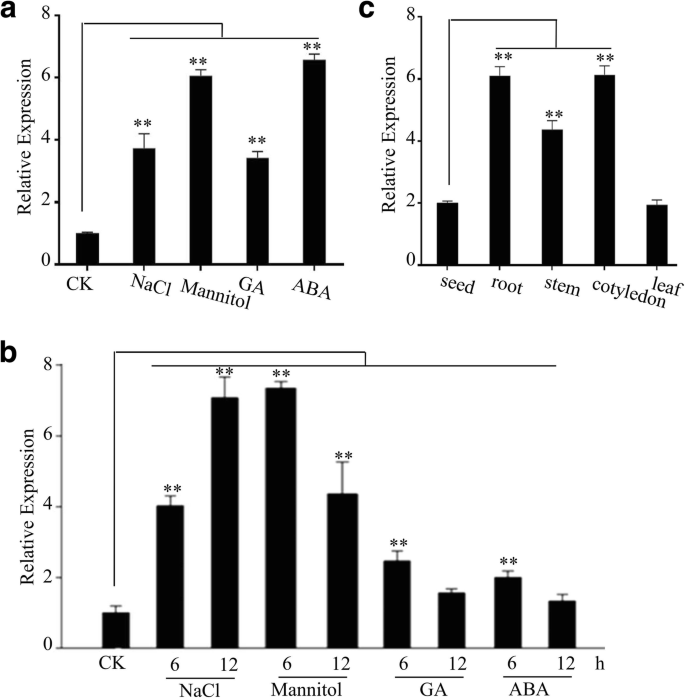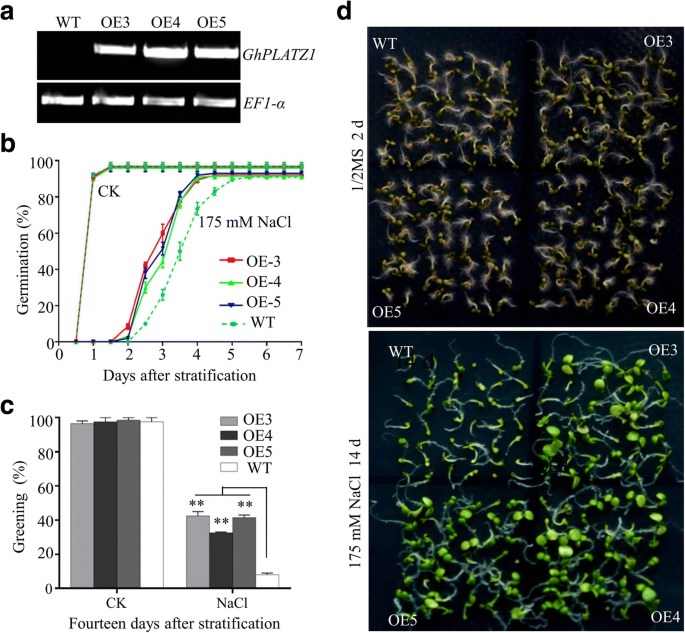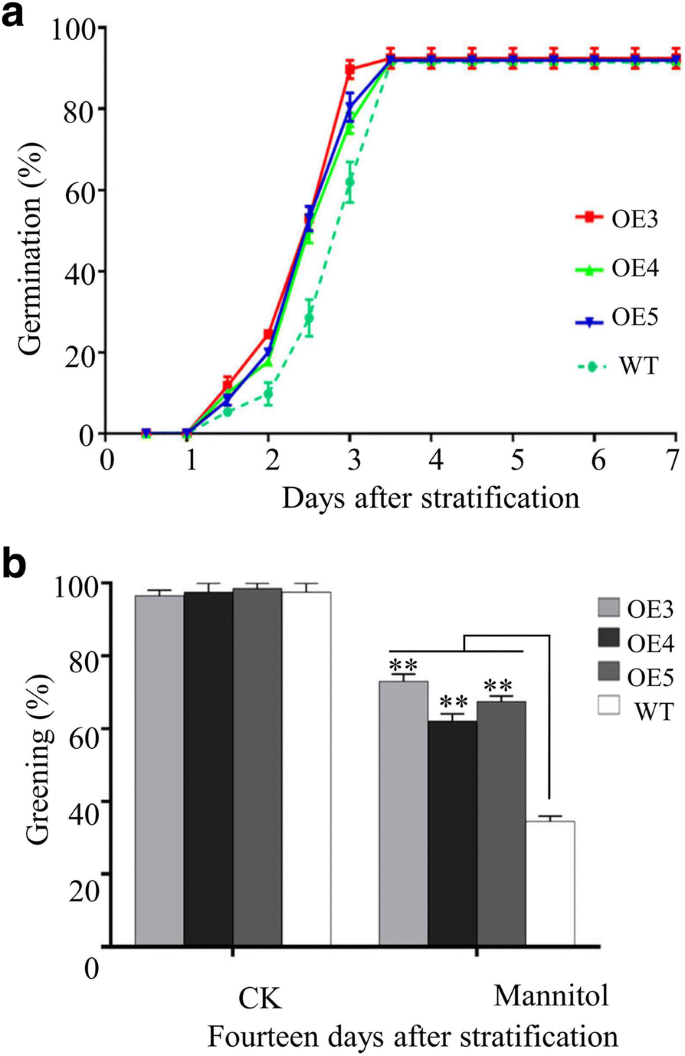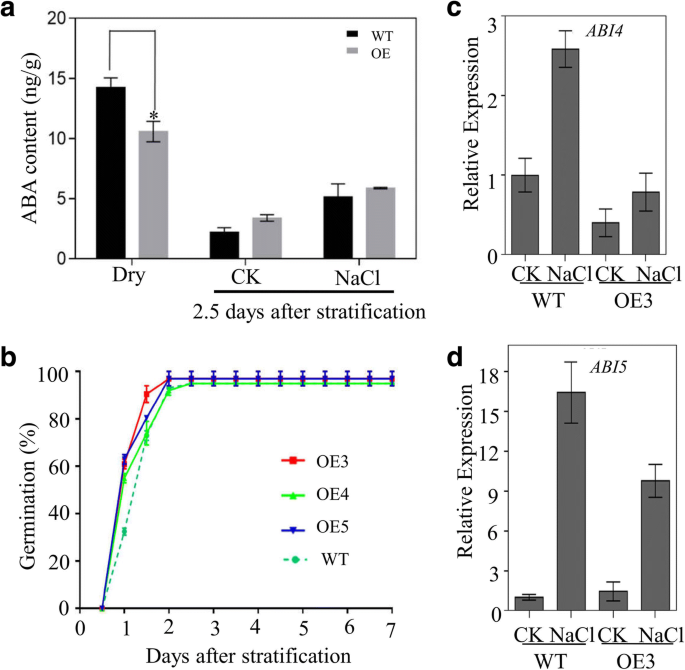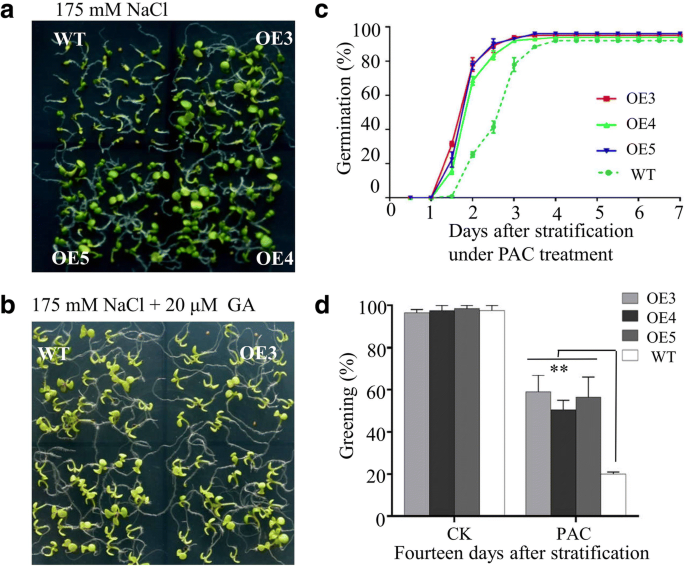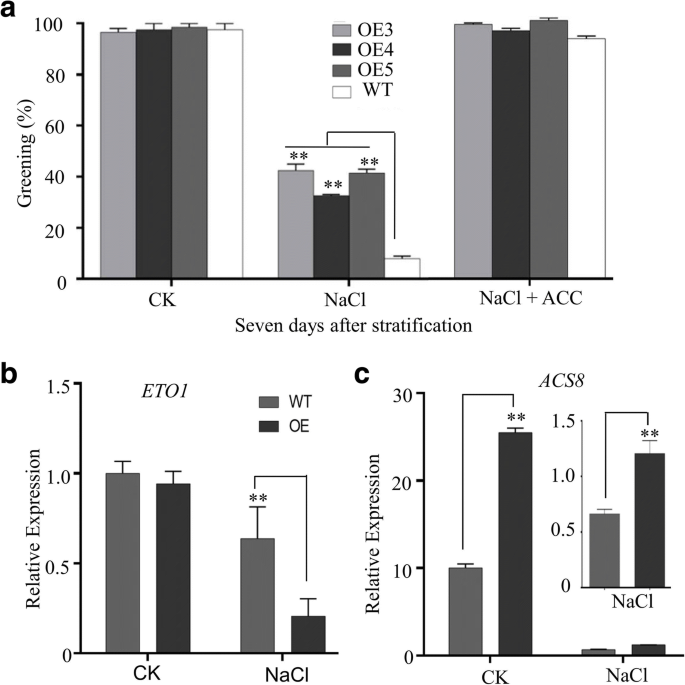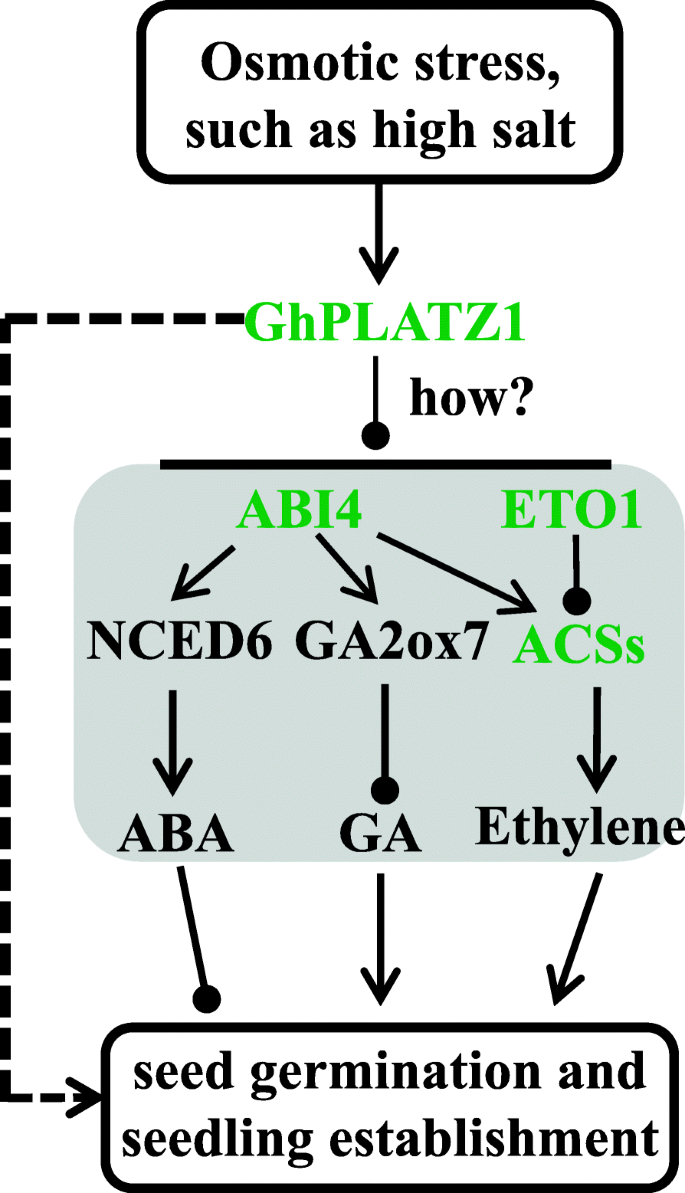- Research article
- Open Access
- Published:
Expression of cotton PLATZ1 in transgenicArabidopsisreduces sensitivity to osmotic and salt stress for germination and seedling establishment associated with modification of the abscisic acid, gibberellin, and ethylene signalling pathways
BMC Plant Biologyvolume18, Article number:218(2018)
Abstract
Background
Zinc-finger transcription factors play central roles in plant growth, development and abiotic stress responses. PLATZ encodes a class of plant-specific zinc-finger transcription factor. However, biological functions or physiological mechanism controlled by PLATZ are currently limited.
Results
GhPLATZ1transcripts were considerably up-regulated by NaCl, mannitol, abscisic acid (ABA) and gibberellin (GA) treatments. TransgenicArabidopsisby ectopic expression ofGhPLATZ1exhibited faster seed germination and higher seedling establishment under salt and mannitol stresses than those of wild type (WT), indicating enhanced osmotic insensitivity inGhPLATZ1transgenicArabidopsis. The ABA content in dry seeds ofGhPLATZ1transgenicArabidopsiswas lower than that of WT whereas the ABA content was not changed in germinating seeds under salt stress. Seed germination was faster than but the seedling establishment of transgenicArabidopsiswas similar to WT. Besides,GhPLATZ1transgenic and WTArabidopsisexhibited insensitivity to paclobutrazol (PAC), a GA biosynthesis inhibitor, whereas exogenous GA could eliminate the growth difference betweenGhPLATZ1transgenic and WTArabidopsisunder salt stress. Moreover, exogenous 1-aminocyclopropane-1-carboxylic acid (ACC), an ethylene precursor, exerted similar effects to GA.Furthermore,ABI4andETO1transcripts were significantly down-regulated, whereasACS8was up-regulated inGhPLATZ1transgenicArabidopsisunder salt stress.
Conclusions
In conclusion, GhPLATZ1 had broad influence in responses to salt and mannitol stresses in transgenicArabidopsisduring seed germination and seedling establishment. The effect of GhPLATZ1 expression in transgenic Arabidopsis might be mediated by the ABA, GA, and ethylene pathways. Thus, this study provided new insights into the regulatory network in response to abiotic stresses in plants.
Background
Impaired germination and postgermination growth are common among seeds exposed to salt and drought stresses. Plants can regulate and coordinate both growth and/or stress sensitivity to promote survival or escape from environmental stress by modifying the production, distribution, or signal transduction of hormones. Thus, identification of components involved in hormonal regulation during germination under abiotic stresses is essential.
A large number of genes encoding DNA-binding proteins, which play important roles in hormone mediated responses to abiotic stresses were identified in plants. For example, the major downstream components of abscisic acid (ABA) signaling, namely, ABA insensitive 3 (ABI3) [1], ABI4 [2] and ABI5 [3,4], are positive regulators of ABA, and they are crucial in seed maturation, seed germination and seedling growth [5]。Fuctional loss of these genes causes fast germination under ABA and abiotic stresses. The GA signaling pathways depend on DELLA proteins including GA insensitive ones (GAI), repressor ofga1–3(RGA), repressor ofga1–3-like (RGL) 1, RGL2 and RGL3 [6,7]。GA destabilizes the DELLA proteins, which act as growth repressors, by targeting ubiquitination and degradation [8]。EIN2 plays a key role in ethylene signaling and losing its function results in a hypersensitivity to salt and osmotic stress during germination and early seedling development inArabidopsis[9]。ERFgenes might also play a pivotal role in ethylene responsiveness and germination regulation in tomato (Solanum lycopersicon);SlERF2overexpression in transgenic lines causes premature seed germination [10]。
Zinc-finger transcription factors are a relatively large family of plant transcription factors (approximately 15% of the total) and play central roles in plant growth and development [11,12]。PLATZ1 was first isolated from pea [13]。PLATZ1 and its paralogs fromArabidopsisand other species have two consensus signatures, namely, C-x2-H-x11-C-x2-C-x(4–5)-C-x2-C-x(3–7)-H-x2-H (CHC4H2) and C-x2-C-x(10–11)-C-x3-C. However, the two consensus signatures are different from those of previously characterized zinc-binding motifs, such as RING (C3HC4), LIM (C2HC5) [14], GATA finger (C-x2-C-x(17–18)-C-x2-C (C2C2)) [15,16], COSTANS/CONSTANS-like (CO/COLs) [17], and the DNA-binding one finger (Dof) [18]。Hence PLATZs encode a novel class of plant-specific zinc-finger transcription factors. Recently, Arabidopsis PLATZ1 and 2 were reported to positively regulate acquisition of dessication tolerance in seeds and vegetative tissues [19]。Maize PLATZ protein FL3 is involved in tRNA and 5S rRNA transcription through interaction with RNA polymerase III [20]。Multiple members ofPLATZgenes exist in plants. For example, 12PLATZgenes exist in theArabidopsisgenome (https://www.arabidopsis.org/servlets/Search?type=general&search_action=detail&method=1&show_obsolete=F&name=PLATZ&sub_type=gene&SEARCH_EXACT=4&SEARCH_CONTAINS=1/). Therefore, the roles of PLATZs remain largely unclear.
Cotton (Gossypium hirsutum) is one of the most important fibre and oil crops. Cotton seed germination and seedling establishment are severely impaired in abiotic stress conditions. The biological significance of cotton PLATZs has not yet been described. In this study, the first PLATZ form cotton, named as GhPLATZ1, was isolated and characterized. Our results indicated that the expression ofGhPLATZ1was induced by abiotic and hormone stimuli. Ectopic expression ofGhPLATZ1inArabidopsisresulted in enhanced insensitivity to osmotic stresses, ABA and PAC. We deduced that GhPLATZ1 might play important roles in regulating hormone-mediated osmotic stress during cotton seed germination and seedling establishment.
Results
Characterization of GhPLATZ1Transcription factor
We previously showed that a gene (GenBank ID: JQ837703) from cotton was significantly induced by salt stress [21]。The deduced amino acid sequence was homologous to PLATZ1 from peas and PLATZs fromArabidopsis. Given that the gene was the first isolated PLATZ from cotton, we named it asGhPLATZ1. Genome-wide searching inG.hirtusiumandArabidopsis thalianarevealed that 9PLATZgenes exist in cotton (https://phytozome.jgi.doe.gov) and 12 are inArabidopsis[the Arabidopsis Information Resource (TAIR),https://www.arabidopsis.org/servlets/Search?type=general&search_action=detail&method=1&show_obsolete=F&name=PLATZ&sub_type=gene&SEARCH_EXACT=4&SEARCH_CONTAINS=1]。GhPLATZs showed high identity with each other (≥79.56%) (Additional file1: Figure S1A), and all of them shared numerous similarities to a subfamily of AtPLATZs, including AtPLATZ3, AtPLATZ11, and AtPLATZ12 (Additional file1: Figure S1B). However, the roles of GhPLATZs remain unclear.
To explore the possible roles of GhPLATZ1 under salt stress and other abiotic stresses, the expression ofGhPLATZ1was determined in 20-day-old seedlings by qRT-PCR usingGhUBI(EU604080) as the reference gene.GhPLATZ1transcripts were induced by 3.8, 6.2, 6.8, or 3.6-fold by NaCl, mannitol, GA, or ABA treatment, respectively (Fig.1a). During seed germination,GhPLATZ1transcripts were up-regulated by 4.1 and 7.2-fold or 7.5 and 4.5-fold by NaCl or mannitol treatment at 6 and 12 h, respectively, or two fold by GA and ABA treatments at 6 h (Fig.1b). In addition, high levels ofGhPLATZ1transcripts were detected in roots, stems and cotyledons, whereas low transcripts were found in leaves and seeds (Fig.1c). These data suggested thatGhPLATZ1may be involved in plant responses to environmental stimuli.
The expression patterns ofGhPLATZ1analyzed by qRT-PCR.aGhPLATZ1expression in 20-day-old seedlings treated with or without 200 mM NaCl, 300 mM mannitol, 50 μM GA or 50 μM ABA for 6 h.bGhPLATZ1expression in 2.5-day germinated seeds in Hoagland solutions with or without 200 mM NaCl, 300 mM mannitol, 50 μM GA or 50 μM ABA for 6 and 12 h. The transcript levels were normalized to that ofGhUBI(EU604080). Values are means ± SD of three replicates.cGhPLATZ1expression in seeds, roots, stems, cotyledens or leaves of 20-day-old cotton seedlings. At least three independent experiments were conducted
GhPLATZ1transgenicArabidopsisenhances insensitivity to osmotic stresses
To further analyze the function ofGhPLATZ1, we introduced 35S::GhPLATZ1intoArabidopsis, and obtained three independent transgenic lines with high levels ofGhPLATZ1transcripts (Fig.2a) for further analysis.
Phenotypic analysis ofGhPLATZ1transgenicArabidopsisunder salt stress.aDetermination ofGhPLATZ1expression in the three independent transgenic T3Arabidopsis纯合子OE3、OE4 OE5和WT。bGermination rates of WT, OE3, OE4, and OE5 seeds germinated on 1/2 MS medium with or without 175 mM NaCl for indicated time points after stratification.cCotyledon greening of WT, OE3, OE4, and OE5 plants grown on 1/2 MS medium with or without 175 mM NaCl for 14 days after stratification.dPhotographs of 2-day germinated seeds under 1/2 MS medium (upper) and 14-day-old seedlings under 1/2 MS medium containing 175 mM NaCl (lower). 1/2 MS medium was used as control (CK). Data showed the mean ± SD (n = 50) of three replicates
When seeds of WT and three transgenic lines were sown on 1/2 MS medium, the three transgenic lines showed similar seed germination and seedling establishment to WT did (Fig.2bandc; Additional file1: Figures. S2 and S3). However, when subjected to 1/2 MS medium with 175 mM NaCl, the three transgenic lines exhibited more than 20% higher germination rates than WT during 2.5–4 days, and reached the maximum germination rate 1.5 days earlier than WT (Fig.2b). Cotyledon greening was also more than 20% higher in the transgenic lines compared to WT (Fig.2candd). Similar results were obtained when seeds of WT and three transgenic lines were subjected to 1/2 MS medium with 150 and 200 mM NaCl (Additional file1: Figures. S2 and S3). Under treatment of 175 mM KCl, 100 mM Na2SO4, and 300 mM mannitol, the three transgenic lines also exhibited quicker germination than WT (Additional file1: Figures S4A and S4B; Fig.3a), and more than 30% higher cotyledon greening at 14 days for mannitol treatment (Fig.3b) than WT. However, when treated with 15 mM LiCl, the three transgenic lines exhibited similar seed germination and cotyledon greening to WT (Additional file1:图自己和S4D)。为了确定whether ectopic expression of GhPLATZ1 alters the expression of the native PLATZ genes inArabidopsis,表达水平s of 12 members ofAtPLATZgenes were determined by qRT-PCR. Eleven of the 12AtPLATZgenes were detected, and their expression levels were not significantly changed inGhPLATZ1transgenic lines (Additional file1: Figure S5). However, we did not find a phenotypic difference betweenGhPLATZ1transgenic and WTArabidopsisin vegetative tissues in the presence and absence of salt and mannitol stresses (data not shown). Thus,GhPLATZ1transgenic lines decreased the sensitivity to osmotic stress during seed germination and postgermination growth.
Phenotypic analysis ofGhPLATZ1in transgenic Arabidopsis under mannitol stress.aGermination rates of WT, OE3, OE4, and OE5 seeds on 1/2 MS medium with 300 mM mannitol for indicated times.bCotyledon-greening of WT, OE3, OE4, and OE5 plants grown on 1/2 MS medium with or without 300 mM mannitol for 14 days. Data show the mean ± SD (n = 40) of three replicates. At least 40 seeds per genotype were measured in each replicate
GhPLATZ1 inhibits ABA biosynthesis
To investigate whether GhPLATZ1 functions through ABA in transgenic plants, ABA contents were measured. The result showed that dry seeds ofGhPLATZ1transgenic lines contained significantly lower ABA level than WT, whereas germinated seeds ofGhPLATZ1transgenic lines contained similar ABA level to WT at 2.5-day-germination stage with or without NaCl treatment (Fig.4a).GhPLATZ1transgenic lines showed quicker germination than WT only before 2 d of germination in the presence of exogenous ABA, but similar phenotype after 2 d of germination (Fig.4b).ABI4expression inGhPLATZ1transgenic lines was down-regulated 2-fold compared with WT at 2.5-day-germination stage with or without NaCl treatment (Fig.4c); andABI5expression was suppressed by less than two fold (Fig.4d). These data indicated that GhPLATZ1 inhibited ABA biosynthesis in developing seeds, which might lead to rapid germination in the early stages.
ABA response of GhPLATZ1 transgenic and WT plants.aQuantification of ABA content in dry seeds and 2.5-day germinated seeds in 1/2 MS medium with or without 175 mM NaCl.bGermination rates of WT, OE3, OE4, and OE5 seeds on 1/2 MS medium containing 5 μM ABA or indicated times.cThe relative expression ofABI4anddABI5in WT and OE3 seeds germinated for 2 days on 1/2 MS medium with or without 175 mM NaCl. Data show the mean ± SD (n = 49) of three replicates. At least three independent experiments were conducted
GhPLATZ1 involves GA and ethylene-mediated salt stress responses
Upon comparing Fig.5bwith Fig.5a, we found that seed germination was less sensitive to NaCl after the addition of exogenous GA in bothGhPLATZ1transgenic lines and WT. Under PAC treatment, we observed 40% lower seed germination at 2–3 days (Fig.5c), and 30% lower cotyledon greening at 14 days (Fig.5d) in WT than inGhPLATZ1transgenic lines were obtained. Therefore, GhPLATZ1 was involved in the GA-mediated salt stress response of plants during seed germination and postgermination growth.
Responses of GhPLATZ1 transgenic and WT plants to GA and PAC.aPhotograph of seedlings grown for 14 days on 1/2 MS medium containing 175 mM NaCl (b) Photograph of seedlings grown for 7 days on 1/2 MS medium containing 175 mM NaCl and 20 μM GA.cGermination rates of WT, OE3, OE4, and OE5 seeds on 1/2 MS medium containing 40 μM PAC for indicated times. Data show the mean ± SD (n = 56) of three replicates.dCotyledon-greening of WT, OE3, OE4, and OE5 plants grown for 14 days on 1/2 MS medium with or without 40 μM PAC. Data show the mean ± SD (n = 56) of three replicates. At least three independent experiments were conducted
We also found that seed germination was less sensitive to NaCl after the addition of exogenous ACC in bothGhPLATZ1transgenic lines and WT (Fig.6a).ETO1(Ethylene-overproduction protein 1) was significantly down-regulated by twofold under salt stress inGhPLATZ1transgenic lines compared with WT (Fig.7b).ACS8was up-regulated by 1.5 times under control and salt stress conditions inGhPLATZ1transgenic lines compared with WT (Fig.7c). Thus, GhPLATZ1 was involved in the ethylene-mediated salt stress response in plants during seed germination and postgermination growth.
Responses of GhPLATZ1 transgenic and WT plants to ethylene.aCotyledon greening of WT, OE3, OE4, and OE5 seedlings grown on 1/2 MS medium with or without 175 mM NaCl, or 175 mM NaCl and 5 μM ACC for 14 days. Data show the mean ± SD (n = 49) of three replicates.bThe relative expression ofETO1andcACS8in 3.5-d germinated seeds of WT and OE3 on 1/2 MS medium with or without 175 mM NaCl. At least three independent experiments were conducted
Discussion
More than 10 years ago, PLATZ1 was isolated from pea and characterized as a plant-specific zinc-dependent transcription repressor [13]。Recently, only Arabidopsis PLATZ1 and 2 [19),和玉米坐蛋白质FL3 [20] were reported to be involved in abiotic stress and seed development, respectively. Therefore, the roles of PLATZs remain largely unclear.
In the present study, we illustrated that theGhPLATZ1expression was significantly induced by salt, mannitol, ABA and GA in 20-day-old plants and germinated seeds (Fig.1aandb), thereby suggesting the involvement of GhPLATZ1 in multiple abiotic stress responses.GhPLATZ1transgenic lines showed significantly enhanced osmotic, salt, ABA, and PAC insensitivity during seed germination and seedling establishment (Figs.2,3,4and5). This function of GhPLATZ1 is similar to that of AtPLATZ1 and AtPLATZ2 whose mutantsplatz1andplatz2increased sensitivity to ABA [19]; thus GhPLATZ1 might function similarly to AtPLATZ1 and AtLATZ2 during seed germination. However,GhPLATZ1转基因植物表现出相似的表型WTin vegetative tissues under normal, salt and mannitol conditions (data not shown), whereas constitutive expression of AtPLATZ1 conferred tolerance to low water availability [19]。Therefore, PLATZs from different species may function similarly in some developing stages but differently in other developing stages in response to abiotic stresses.
Impaired germination and postgermination growth are common among seeds exposed to salt and drought stresses. Plants can regulate and coordinate both growth and/or stress tolerance to promote survival or escape from environmental stress by modifying the production, distribution, or signal transduction of hormones. The hormonal balance between ABA and GA in seed germination in response to environmental stimuli is well documented and discussed [5,22,23,24]。ABA plays crucial roles in dormancy induction in developing seeds and in dormancy maintenance in seed imbibition, whereas GAs are involved in germination. Exogenous ABA application inhibits germination in a dose-dependent manner. Applying fluridone, an ABA biosynthesis inhibitor, substantially stimulates seed germination under salinity [1]。The seeds of typical ABA-deficient mutants germinate faster than those of WT [25], and transgenic plants constitutively expressing the ABA biosynthesis gene maintain considerable seed dormancy [26,27]。In contrast, GA3enhances germination under NaCl stress [28]。GA-deficient mutants, such asga1andga2, show strong seed dormancy and fail to germinate without exogenous GA treatment [2]。Mutants that are defective in GA 2-oxidases, which deactivate bioactive GA, show decreased seed dormancy [29]。Compared with WT, our data indicated low levels of ABA in dry seeds of GhPLATZ1 transgenicArabidopsis(Fig.4a). This result may lead to the insensitivity of GhPLATZ1 transgenicArabidopsisseeds to osmotic stress and ABA compared with WT. The down-regulation ofABI4expression (Fig.4c) confirmed the insensitivity of GhPLATZ1 transgenicArabidopsisseeds to osmotic stress and ABA. By contrast, the different responses of GhPLATZ1 transgenic and WTArabidopsisto PAC indicated the potential high GA in GhPLATZ1 transgenicArabidopsisin response to salt stress. Therefore, the major active GA forms such as GA1和遗传算法4need further investigated. The transcription of a key ABA biosynthetic gene,NCED6, and key GA catabolic gene,GA2ox7, is significantly enhanced byABI4overexpression by directly binding to their promoters; and ABA inducesGA2ox7transcription whereas GA repressesNCED6expression in an ABI4-dependent manner; and ABA stabilizes the ABI4 protein whereas GA promotes its degradation [30]。Thus, GhPLATZ1 might function in ABA and GA antagonism by suppressingABI4transcription and inhibiting the activating expression ofNCED6andGA2ox7,reby leading to decreased ABA and increased GA (Fig.7).
In addition, ethylene accelerates seed germination by overcoming the inhibitory action of ABA or stimulating GA biosynthesis or its signaling pathway [31]。Two results indicated that GhPLATZ1 increased ethylene production: first,ACS8, a gene that encodes ethylene biosynthesis, showed up-regulated expression inGhPLATZ1transgenic lines compared with WT (Fig.6c).ABI4transcripts were significantly suppressed inGhPLATZ1transgenic lines (Fig.4c). Increasing evidence has revealed that ABI4 binds directly to promoters ofACS4,ACS8, andACO2to inhibit their transcription causing reduced ethylene production [32]。因此,明显suppressedABI4transcripts inGhPLATZ1transgenic lines suggested the up-regulated expression of ethylene biosynthesis genes, such asACS4,ACS8, andACO2. Here, we detected the expression of ACS8, a member of a gene family encoding ethylene biosynthetic enzymes, was up-regulated in GhPLATZ1 in transgenic lines (Fig.6c). Second,ETO1showed significantly down-regulated expression inGhPLATZ1transgenic lines (Fig.6b). ETO1 is a component of the E3-ligase complex and interacts directly with ACS5 and Le-ACS3 for degradation in a proteasome-dependent manner [32,33,34,35]。Mutated ETO1 forms result in increased ACS5 protein stability and ethylene overproduction [33]。Therefore, the significantly down-regulation ofETO1inGhPLATZ1transgenic lines (Fig.6b) also suggested increased ethylene levels inGhPLATZ1transgenic lines. The results of ACC (the direct precursor of ethylene) application (Fig.7a) further indicated the higher ethylene inGhPLATZ1transgenic lines than WT. Thus, GhPLATZ1 might increase ethylene production by down-regulating the expression ofABI4andETO1genes (Fig.7).
Conclusions
In conclusion, this study discovered a new regulator,GhPLATZ1, which was induced by NaCl, mannitol, ABA and GA treatments. The model in Fig.7shows howGhPLATZ1functions in osmotic stresses during seed germination and seedling establishment. First, GhPLATZ1 increases osmotic insensitivity of transgenicArabidopsisby inhibitingABI4expression, which can induce the expression ofNCED6andGA2ox7. Second, GhPLATZ1 inhibitsABI4andETO1expression, which can suppressACSgene expression and decrease ACS protein stability, respectively. Therefore, GA and ethylene possibly increased and ABA decreases inGhPLATZ1transgenic Arabidopsis to promote seed germination and seedling establishment under osmotic stress. However, overexpression of ABI4 and ETO1 in GhPATZ1 transgenic Arabidopsis will confirm this conclusion. However, GhPLATZ1 regulates the expression levels ofABI4andETO1, as well as what and how other signaling participate in GhPLATZ1-mediated pathways remains unknown.
Methods
Plant materials and treatments
Seeds of upland cotton (Gossypium hirtusium.L) cultivar ZM19 were bought from Chinese Academy of Agricultural Sciences. Seedlings were grown for 20 days in MS liquid medium in a growth chamber with 300 μM m− 2·s− 1light intensity and day/night temperatures of 28 °C/20 °C. For each treatment, every 15 uniformly developed seedlings were transferred to MS media containing either 200 mM NaCl, 300 mM mannitol, 50 μM ABA or 50 μM GA312 h。此外,种子发芽在水中for 2.5 days with 0.5 cm radicles were also treated with MS media containing either 200 mM NaCl, 300 mM mannitol, 50 μM ABA or 50 μM GA3for 6 and 12 h, respectively. Twenty-day seedlings or 2.5-d germinated seeds transferred to MS media were used as control. Samples were harvested at the indicated points, frozen in liquid nitrogen, and stored at − 70 °C for RNA extraction. Each treatment was repeated three times.
向量构造和转换
To construct 35S::GhPLATZ1,GhPLATZ1coding sequence was amplified using cDNA by PCR with gene specific primers (Additional file2: Table S1). The resulting PCR product was cloned into theSalI andKpnI sites of binary vector pBI121 under the control of a cauliflower mosaic virus 35S promoter.
The 35S::GhPLATZ1was then introduced intoAgrobacterium tumefaciensstrain GV3101 to be transformed intoArabidopsis thalianaecotype Columbia-0 by floral dipping [36]。The transgenic plants were screened on 1/2 MS medium containing 50 mg·L− 1. kanamycin. Two generations of the corresponding T1transgenic seedlings segregated at a ratio of 3:1 (resistant:sensitive) were selected to propagate T3homozygous. Some of the transgenicArabidopsisplants were confirmed by detecting the expression ofGhPLATZ1by PCR and used for further experiments. Primers are listed in Additional file2: Table S1.
RNA extraction
The total RNAs of different cotton samples used in this report were isolated using RNeasy Plant Mini Kit (QIAGEN). The total RNAs of 20-day-old seedlings and germinated seeds of differentArabidopsistransgenic lines were isolated using a Universal Plant Total RNA Extraction Kit (spin-column)-I (BioTeke Beijing China).
Quantitative RT-PCR
qRT-PCR was performed as previously described [37]。CottonGhUBI(EU604080) orArabidopsis actin2genes were used as the standard control. The relativeGhPLATZ1 and AtPLATZs表达水平was analyzed using the comparative CT method, and three replicates of each sample were analyzed. All of the primers used are listed in Additional file2: Table S1. At least three independent experiments were carried out.
Fluorescence microscopy
Roots from seven-day-old transgenic Arabidopsis containing 35S::GhPL-GFPwere used and imaged by LSCM51 (Zeiss) at 488 nm for GFP.
Seed germination and cotyledon greening analysis
每个基因型收获从植物的种子of the same age and stored for 4 weeks in the dark at 4 °C. For each comparison, seeds were surface-sterilized with 70% ethanol for 5 min, subsequently incubated in 2.6% sodium hypochlorite for 10 min, and washed five times with sterile water. At least 30 sterile seeds were plated on 1/2 MS medium plus 1% (w/v) sucrose with or without different concentrations of NaCl, KCl, Na2SO4, LiCl, mannitol, ABA, PAC, or NaCl combined with GA or ACC as indicated. Plates were chilled at 4 °C in the dark for 3 days (stratification) and moved to 22 °C with a 16-h-light/8-h-dark cycle. The percentage of seed germination was determined at indicated time points. Germination was defined as an obvious emergence of the radicle through the seed coat. The percentage of cotyledon greening was recorded at 14 days after the end of stratification. Cotyledon greening was defined as obvious cotyledon expansion and turning of cotyledon color into green. Three biological replications were performed.
ABA content measurements
To quantify ABA content, dry seeds and two-day germinated seeds of GhPLATZ1 overexpressingArabidopsisand WT treated with or without 175 mM NaCl were ground in liquid nitrogen. Furthermore, 150 mg of seed powder was homogenized and extracted for 24 h in methanol containing D6-ABA (OIChemIm Co., Ltd.) as an internal standard. The mixture was purified with an Oasis Max solid-phase extract cartridge (150 mg/6 cc; waters) and eluted with 5% formic acid in methanol. The elution was dried and reconstituted. ABA content was measured by HPLC-MS-MS (Agilent 1290 Rapid-resolution Liquid chromatography, Agilent Technologies, Waldbronn, Germany; Sciex 6500 Q-Trap AB Technologies, USA). The mobile phase consisted of A:B (methyl alcohol/0.1% methanoic acid:H2O/0.1% methanoic acid). The elution gradient was 0–2 min, A = 20%; 2–14 min, A = 80%; and 15.1–20 min, A = 20%. The injection volume was 2 μL. The mass spectrometer conditions were as follows: spray voltage, 4500 V; atomizer pressure, 65 psi; assist device pressure, 70 psi; atomization temperature, 400 °C.
Statistical analysis
Data were subjected to data processing system and significant differences were established through one-way ANOVA. Differences at 5% and 1% levels were considered significant and denoted by single and double stars (*P < 0.05; **P < 0.01).
Abbreviations
- ABA:
-
Abscisic acid
- ABI:
-
ABA insensitive
- ACC:
-
1-aminocyclopropane-1-carboxylic acid
- ACS:
-
ACC synthase
- CK:
-
Control
- ETO1:
-
Ethylene-overproduction protein 1
- GA:
-
Gibberellin
- MS:
-
Murashige and Skoog
- OE:
-
Transgenic arabidopsis with highGhPLATZ1overexpression
- PAC:
-
Paclobutrazol
- WT:
-
Wild type
References
- 1.
Finkelstein RR, Gampala SS, Rock CD. Abscisic acid signaling in seeds and seedlings. Plant Cell. 2002;14(Suppl):S15–45.
- 2.
Shu K, Zhang H, Wang S, Chen M, Wu Y, Tang S, Liu C, Feng Y, Cao X, Xie Q. ABI4 regulates primary seed dormancy by regulating the biogenesis of abscisic acid and gibberellins in arabidopsis. PLoS Genet. 2013;9:e1003577.
- 3.
Finkelstein RR, Lynch TJ. The Arabidopsis abscisic acid response gene ABI5 encodes a basic leucine zipper transcription factor. Plant Cell. 2000;12:599–609.
- 4.
Lopez-Molina L, Mongrand S, Chua NH. A postgermination developmental arrest checkpoint is mediated by abscisic acid and requires the ABI5 transcription factor in Arabidopsis. Proc Natl Acad Sci U S A. 2001;98:4782–7.
- 5.
Shu K, Liu XD, Xie Q, He ZH. Two faces of one seed: hormonal regulation of dormancy and germination. Mol Plant. 2016;9:34–45.
- 6.
J.M. Daviere, P. Achard, Gibberellin signaling in plants, development (Cambridge, England), 140 (2013) 1147–1151.
- 7.
Sun TP, Gubler F. Molecular mechanism of gibberellin signaling in plants. Annu Rev Plant Biol. 2004;55:197–223.
- 8.
Dill A, Thomas SG, Hu J, Steber CM, Sun TP. The Arabidopsis F-box protein SLEEPY1 targets gibberellin signaling repressors for gibberellin-induced degradation. Plant Cell. 2004;16:1392–405.
- 9.
Wang Y, Liu C, Li K, Sun F, Hu H, Li X, Zhao Y, Han C, Zhang W, Duan Y, Liu M, Li X. Arabidopsis EIN2 modulates stress response through abscisic acid response pathway. Plant Mol Biol. 2007;64:633–44.
- 10.
Pirrello J, Jaimes-Miranda F, Sanchez-Ballesta MT, Tournier B, Khalil-Ahmad Q, Regad F, Latche A, Pech JC, Bouzayen M. Sl-ERF2, a tomato ethylene response factor involved in ethylene response and seed germination. Plant & cell physiology. 2006;47:1195–205.
- 11.
Kielbowicz-Matuk A. Involvement of plant C(2)H(2)-type zinc finger transcription factors in stress responses. Plant science : an international journal of experimental plant biology. 2012;185-186:78–85.
- 12.
Riechmann JL, Heard J, Martin G, Reuber L, Jiang C, Keddie J, Adam L, Pineda O, Ratcliffe OJ, Samaha RR, Creelman R, Pilgrim M, Broun P, Zhang JZ, Ghandehari D, Sherman BK, Yu G. Arabidopsis transcription factors: genome-wide comparative analysis among eukaryotes, science (New York). NY. 2000;290:2105–10.
- 13.
Nagano Y, Furuhashi H, Inaba T, Sasaki Y. A novel class of plant-specific zinc-dependent DNA-binding protein that binds to a/T-rich DNA sequences. Nucleic Acids Res. 2001;29:4097–105.
- 14.
Schwabe JW, Klug A. Zinc mining for protein domains. Nat Struct Biol. 1994;1:345–9.
- 15.
Teakle GR, Manfield IW, Graham JF, Gilmartin PM. Arabidopsis thaliana GATA factors: organisation, expression and DNA-binding characteristics. Plant Mol Biol. 2002;50:43–57.
- 16.
Manfield IW, Devlin PF, Jen CH, Westhead DR, Gilmartin PM. Conservation, convergence, and divergence of light-responsive, circadian-regulated, and tissue-specific expression patterns during evolution of the Arabidopsis GATA gene family. Plant Physiol. 2007;143:941–58.
- 17.
Griffiths S, Dunford RP, Coupland G, Laurie DA. The evolution of CONSTANS-like gene families in barley, rice, and Arabidopsis. Plant Physiol. 2003;131:1855–67.
- 18.
Noguero M, Atif RM, Ochatt S, Thompson RD. The role of the DNA-binding one zinc finger (DOF) transcription factor family in plants. Plant science : an international journal of experimental plant biology. 2013;209:32–45.
- 19.
Gonzalez-Morales SI, Chavez-Montes RA, Hayano-Kanashiro C, Alejo-Jacuinde G, Rico-Cambron TY, de Folter S, Herrera-Estrella L. Regulatory network analysis reveals novel regulators of seed desiccation tolerance in Arabidopsis thaliana. Proc Natl Acad Sci U S A. 2016;113:E5232–41.
- 20.
Li Q, Wang J, Ye J, Zheng X, Xiang X, Li C, Fu M, Wang Q, Zhang Z, Wu Y. The maize imprinted gene floury3 encodes a PLATZ protein required for tRNA and 5S rRNA transcription through interaction with RNA polymerase III. Plant Cell. 2017;https://doi.org/10.1105/tpc.17.00576.
- 21.
Wang G, Zhu Q, Meng Q, Wu C. Transcript profiling during salt stress of young cotton (Gossypium hirsutum) seedlings via Solexa sequencing. Acta Physiol Plant. 2012;34:107–15.
- 22.
Finkelstein R, Reeves W, Ariizumi T, Steber C. Molecular aspects of seed dormancy. Annu Rev Plant Biol. 2008;59:387–415.
- 23.
Rajjou L, Duval M, Gallardo K, Catusse J, Bally J, Job C, Job D. Seed germination and vigor. Annu Rev Plant Biol. 2012;63:507–33.
- 24.
Colebrook EH, Thomas SG, Phillips AL, Hedden P. The role of gibberellin signalling in plant responses to abiotic stress. J Exp Biol. 2014;217:67–75.
- 25.
弗雷A, Effroy D, Lefebvre V, Seo M, Perreau F, Berger A, Sechet J, A. To, North HM, Marion-Poll A. Epoxycarotenoid cleavage by NCED5 fine-tunes ABA accumulation and affects seed dormancy and drought tolerance with other NCED family members. The Plant journal : for cell and molecular biology. 2012;70:501–12.
- 26.
Martinez-Andujar C, Ordiz MI, Huang Z, Nonogaki M, Beachy RN, Nonogaki H. Induction of 9-cis-epoxycarotenoid dioxygenase in Arabidopsis thaliana seeds enhances seed dormancy. Proc Natl Acad Sci U S A. 2011;108:17225–9.
- 27.
Nonogaki M, Sall K, Nambara E, Nonogaki H. Amplification of ABA biosynthesis and signaling through a positive feedback mechanism in seeds. The Plant journal : for cell and molecular biology. 2014;78:527–39.
- 28.
Atia A, Debez A, Barhoumi Z, Smaoui A, Abdelly C. ABA, GA(3), and nitrate may control seed germination of Crithmum maritimum (Apiaceae) under saline conditions. Comptes rendus biologies. 2009;332:704–10.
- 29.
Yamauchi Y, Takeda-Kamiya N, Hanada A, Ogawa M, Kuwahara A, Seo M, Kamiya Y, Yamaguchi S. Contribution of gibberellin deactivation by AtGA2ox2 to the suppression of germination of dark-imbibed Arabidopsis thaliana seeds. Plant & cell physiology. 2007;48:555–61.
- 30.
Shu K, Chen Q, Wu Y, Liu R, Zhang H, Wang P, Li Y, Wang S, Tang S, Liu C, Yang W, Cao X, Serino G, Xie Q. ABI4 mediates antagonistic effects of abscisic acid and gibberellins at transcr ipt and protein levels. Plant J. 2016;85:348–61.
- 31.
Dong Z, Yu Y, Li S, Wang J, Tang S, Huang R. Abscisic acid antagonizes ethylene production through the ABI4-mediated transcriptional repression of ACS4 and ACS8 in Arabidopsis. Mol Plant. 2016;9:126–35.
- 32.
Corbineau F, Xia Q, Bailly C, El-Maarouf-Bouteau H. Ethylene, a key factor in the regulation of seed dormancy. Front Plant Sci. 2014;5:539.
- 33.
Wang KL, Yoshida H, Lurin C, Ecker JR. Regulation of ethylene gas biosynthesis by the Arabidopsis ETO1 protein. Nature. 2004;428:945–50.
- 34.
M.J. Christians, D.J. Gingerich, M. Hansen, B.M. Binder, J.J. Kieber, R.D. Vierstra, The BTB ubiquitin ligases ETO1, EOL1 and EOL2 act collectively to regulate ethylene biosynthesis in Arabidopsis by controlling type-2 ACC synthase levels, Plant J : for cell and molecular biology, 57 (2009) 332–345.
- 35.
Yoshida H, Nagata M, Saito K, Wang KL, Ecker JR. Arabidopsis ETO1 specifically interacts with and negatively regulates type 2 1-aminocyclopropane-1-carboxylate synthases. BMC Plant Biol. 2005;5:14.
- 36.
Clough SJ, Bent AF. Floral dip: a simplified method for agrobacterium-mediated transformation of Arabidopsis thaliana. The Plant journal : for cell and molecular biology. 1998;16:735–43.
- 37.
Chen C, Wu C, Miao J, Lei Y, Zhao D, Sun D, Yang G, Huang J, Zheng C. Arabidopsis SAG protein containing the MDN1 domain participates in seed germination and seedling development by negatively regulating ABI3 and ABI5. J Exp Bot. 2014;65:35–45.
Acknowledgments
None.
Funding
This work was supported by the National Natural Science Foundation of China (Grant number 31471425), the Natural Science Foundation of Shandong Province (Grant number ZR2015CM002).
Availability of data and materials
The data sets supporting the results of this article are included within the article and its additional files. Sequence data used in this manuscript can be found in the Arabidopsis Information Resource (TAIR,https://www.arabidopsis.org/servlets/Search?type=general&search_action=detail&method=1&show_obsolete=F&name=PLATZ&sub_type=gene&SEARCH_EXACT=4&SEARCH_CONTAINS=1) and The National Center for Biotechnology Information (https://blast.ncbi.nlm.nih.gov/Blast.cgi), under the following accession numbers: GhPLATZ1 (XP_016742770.1), GhPLATZ2 (XP_016736692.1), GhPLATZ3 (XP_016705363.1), GhPLATZ4 (XP_01672128.1), GhPLATZ5 (XP_012488860.1), GhPLATZ6 (XP_016670611.1), GhPLATZ7 (XP_016723269.1), GhPLATZ8 (XP_016728634.1), GhPLATZ9 (XP_016742383.1), AtPLATZ1.1 (AT1G21000.1), AtPLATZ1.2 (AT1G21000.2), AtPLATZ2 (AT1G76590.1), AtPLATZ3.1 (AT1G32700.1), AtPLATZ3.2 (AT1G32700.2), AtPLATZ4 (AT1G43000.1), AtPLATZ5 (AT1G31040.1), AtPLATZ6 (AT2G01818.1), AtPLATZ7 (AT2G12646.1), AtPLATZ8 (AT2G27930.1), AtPLATZ9 (AT3G50808.1), AtPLATZ10 (AT3G60670.1), AtPLATZ11.1 (AT4G17900.1), AtPLATZ11.2 (T4G17900.2), AtPLATZ12 (AT5G46710.1).
Author information
Affiliations
Contributions
SCZ identified voucher specimen and carried out Arabidopsis transformation, majority of molecular studies and data analysis. SCZ also drafted the manuscript. RY, YQH, and SSL participated in phenotypic analysis, qRT-PCR and references editing. GDY, JGH and CCZ give some advices for experimental design. CAW conceived the study, participated in the design and coordination of this study and drafted the manuscript. All of the authors read and approved the final manuscript.
Corresponding author
Ethics declarations
Ethics approval and consent to participate
Seeds of upland cotton (Gossypium hirtusium.L) cultivar ZM19 were bought from Chinese Academy of Agricultural Sciences.
Consent for publication
Not applicable.
Competing interests
The authors declare that they have no competing interests.
Publisher’s Note
Springer Nature remains neutral with regard to jurisdictional claims in published maps and institutional affiliations.
Additional files
Additional file 1:
Figure S1.Sequence analysis of GhPLATZ1 (GenBank accession no. AFH57272) with its homologs. (A) Multiple alignments of GhPLATZs. Identical amino acids are shaded in black. The conserved zinc-fingers are indicated by C and H at the bottom of the sequences. (BGhPLATZs和AtPLATZs)系统发育分析。The GenBank accession numbers are as follows: GhPLATZ1 (XP_016742770.1), GhPLATZ2 (XP_016736692.1), GhPLATZ3 (XP_016705363.1), GhPLATZ4 (XP_01672128.1), GhPLATZ5 (XP_012488860.1), GhPLATZ6 (XP_016670611.1), GhPLATZ7 (XP_016723269.1), GhPLATZ8 (XP_016728634.1), GhPLATZ9 (XP_016742383.1), AtPLATZ1.1 (AT1G21000.1), AtPLATZ1.2 (AT1G21000.2), AtPLATZ2 (AT1G76590.1), AtPLATZ3.1 (AT1G32700.1), AtPLATZ3.2 (AT1G32700.2), AtPLATZ4 (AT1G43000.1), AtPLATZ5 (AT1G31040.1), AtPLATZ6 (AT2G01818.1), AtPLATZ7 (AT2G12646.1), AtPLATZ8 (AT2G27930.1), AtPLATZ9 (AT3G50808.1), AtPLATZ10 (AT3G60670.1), AtPLATZ11.1 (AT4G17900.1), AtPLATZ11.2 (T4G17900.2), AtPLATZ12 (AT5G46710.1).Figure S2.Phenotypes ofGhPLATZ1transgenic Arabidopsis under salt conditions.(A)Photographs taken at 3, 5, and 7 d on 1/2 MS medium containing different concentrations of NaCl.(B)Germination rates of WT and OE-3 seeds on 1/2 MS medium with or without 175 or 200 mM NaCl in (A).(C)Cotyledon greening of WT and OE-3 seedlings grown on 1/2 MS medium with or without 150, 175 or 200 mM NaCl in (A).Figure S3.Phenotypic analysis of WT andGhPLATZ1transgenic Arabidopsis seeds on 1/2 MS medium for 3.5 d (A) and 1/2 MS medium with or without 200 mM NaCl for14 d (B).Figure S4.Phenotypes ofGhPLATZ1transgenic Arabidopsis under potassium, sodium and lithium stresses. Germination rates of WT, OE-3, OE-4, and OE-5 seeds on 1/2 MS medium with or without 175 mM KCl (A), 100 mM Na2SO4(B), and 15 mM LiCl (C) for indicated times. (D) Cotyledon-greening of WT, OE-3, OE-4, and OE-5 seedlings grown on 1/2 MS medium with or without 15 mM LiCl for 14 days.Figure S5.Expression ofAtPLATZgenes in GhPLATZ1 transgenic and WT plants. AtPLATZ1 (AT1G210001), AtPLATZ2 (AT1G76590.1), AtPLATZ3.1 (AT1G32700.1), AtPLATZ4 (AT1G43000.1), AtPLATZ5 (AT1G31040.1), AtPLATZ6 (AT2G01818.1), AtPLATZ7 (AT2G12646.1), AtPLATZ8 (AT2G27930.1), AtPLATZ9 (AT3G50808.1), AtPLATZ10 (AT3G60670.1), AtPLATZ11.1 (AT4G17900.1), AtPLATZ12 (AT5G46710.1). Primers used here are listed in Additional file2: Table S1. (DOCX 21 kb)
Additional file 2:
Table S1.List of primers used in this study. (DOCX 21 kb)
Rights and permissions
Open AccessThis article is distributed under the terms of the Creative Commons Attribution 4.0 International License (http://creativecommons.org/licenses/by/4.0/), which permits unrestricted use, distribution, and reproduction in any medium, provided you give appropriate credit to the original author(s) and the source, provide a link to the Creative Commons license, and indicate if changes were made. The Creative Commons Public Domain Dedication waiver (http://creativecommons.org/publicdomain/zero/1.0/) applies to the data made available in this article, unless otherwise stated.
About this article
Cite this article
Zhang, S., Yang, R., Huo, Y.et al.Expression of cotton PLATZ1 in transgenicArabidopsisreduces sensitivity to osmotic and salt stress for germination and seedling establishment associated with modification of the abscisic acid, gibberellin, and ethylene signalling pathways.BMC Plant Biol18,218 (2018). https://doi.org/10.1186/s12870-018-1416-0
Received:
Accepted:
Published:
DOI:https://doi.org/10.1186/s12870-018-1416-0
Keywords
- Gossypium hirtusumL
- PLATZ
- Abiotic stresses
- Ethylene
- ABA
- GAs

